
It’s been over 50 years since I saw Verdi’s famous opera “La Traviata”. At that time, there was an organization called “Roen(Workers’ Theater Association)”, and I think I watched it at the monthly meeting. It was the first time I saw an opera and I remember being very impressed. I found a white camellia blooming on the promenade, remembered that, and researched various things about “Tsubakihime(La Traviata)”. “Tsubakihime” is the title given in Japan, and the original title is “La Traviata (corrupted woman)”. It was composed by Verdi, who was asked to make the play “Woman with Camellia Flowers (Tsubakihime)” by Alexandre Dumas Fiss (Small Dumas), which was a big hit around 1852, into an opera. In the tragic love story between the high-class whore Violetta and the young aristocrat Alfredo, Tsubaki appears in the final scene. When Alfredo is about to return, Violetta takes a flower from her breast and hands it to him, saying, “Come on the day when this flower changes color from red to white.” This is the final farewell. By the way, Violetta loved camellia, and she wore a white camellia for 25 days and a red camellia for 5 days in a month.
ヴェルディの有名な歌劇『椿姫』を観たのはもう50年以上の昔になります。当時「労演」と言う組織があり、毎月の例会で観劇した様に思います。歌劇を観たのはそれが初めてでとても感動したのを覚えています。散歩道に咲くシロツバキを見つけてそのことを思い出し、『椿姫』のことをいろいろ調べました。『椿姫』は日本で付けられた題名で, 原題は「ラ・トラヴィアータ(堕落した女)」です。1852年ごろ大当たりしていたアレクサンドル・デュマ・フィス(小デュマ)の戯曲「椿の花をつけた女(椿姫)」を歌劇にする様に依頼されたヴェルディが作曲しました。高級娼婦ヴィオレッタと青年貴族アルフレードの悲恋物語で、最後の場面に出てくるのが椿です。アルフレードが帰ろうとす際、ヴィオレッタが胸から一輪の花を取り出し、「この花の色が赤から白に変わった日においでください」と言って手渡します。これが最後の別れになります。ちなみにヴィオレッタは椿をこよなく愛し、1か月の内25日間は白い椿、5日間は赤い椿を身に付けていたそうです。
